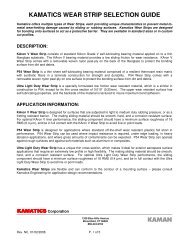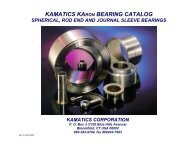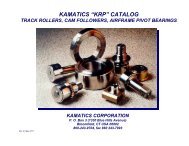Kamatics Karon Design Guide - Kaman Corporation
Kamatics Karon Design Guide - Kaman Corporation
Kamatics Karon Design Guide - Kaman Corporation
You also want an ePaper? Increase the reach of your titles
YUMPU automatically turns print PDFs into web optimized ePapers that Google loves.
KAMATICS CORPORATION<br />
7. Wear Calculations:<br />
Equation 7 incorporates values obtained<br />
from Table 7 to arrive at a predicted<br />
amount of liner wear after an assumed<br />
operation sequence.<br />
Equation 7; Wear Calculation<br />
W = k ∗ d<br />
where;<br />
W = total liner wear in inches<br />
k = wear rate from Table 7, in inches of<br />
liner wear per foot of liner travel.<br />
d = total liner distance traveled in feet<br />
obtained from Equations 4 or 6.<br />
Example: Assume a typical application<br />
is operating at a bearing pressure (P) of<br />
25,000 psi, at an average rubbing<br />
velocity (V) of 1.5 feet per minute and<br />
for a distance of 5000 feet. The product<br />
of the “P” and “V” is well within the<br />
allowable range noted earlier. From<br />
Table 7, locate the point where the<br />
25,000 psi ordinate intersects the “wear”<br />
curve, and follow this intersection point<br />
to the left, parallel to the “x” axis and<br />
obtain the “k” wear factor of 3800 E -10<br />
or 3.8 E -7 . Multiply this “k” factor times<br />
the number of feet traveled and obtain<br />
the amount of liner wear of 0.002 inches<br />
(0.05mm) of liner wear. To this add<br />
0.0005 inches (0.013mm) of “liner seatin”<br />
that may occur within the first 100<br />
feet of travel, for a potential total liner<br />
wear of 0.0025 inches (0.063mm).<br />
8. Bearing Installation:<br />
There has been much written pertaining<br />
to bearing installation and many<br />
companies have established their own<br />
preferences. MIL-STD-1599 offers<br />
some excellent basic recommendations<br />
relative to fit-up and dissimilar metal<br />
considerations. The following is offered<br />
to complement MIL-STD-1599 with<br />
respect to <strong>Kamatics</strong> bearings.<br />
14<br />
KAMAN<br />
Journal Bearing Installation:<br />
The self-lube liner on a journal bearing<br />
is normally supplied unprotected other<br />
than standard wrapping and packaging.<br />
Once removed from its packaging,<br />
handling and installation damage can be<br />
a major concern.<br />
It is important to protect and not subject<br />
the liner from external damage during<br />
the installation process. The tool used to<br />
insert the bearing into the housing must<br />
be free of sharp corners with smooth<br />
beveled edges where it enters the<br />
bearing. The edges of the housing into<br />
which the bearing is being assembled<br />
should be chamfered to assist in<br />
centering the bushing.<br />
In the case of a journal with a lined<br />
flange, the insertion tool should have a<br />
surface as large as the flange OD to<br />
apply the insertion force against. This<br />
will protect the liner on the flange as<br />
well as the liner within the bore. The<br />
force applied to the bearing should be<br />
firm, steady and in one continuous<br />
effort. Pausing before complete<br />
insertion may cause galling of the<br />
bearing OD, housing bore or both.<br />
Figures 14 and 15 offer installation<br />
suggestions and Tables 2 and 3, housing<br />
and shaft sizes. Figure 16 shows<br />
various methods used to retain journal<br />
bearings.<br />
In applications where the user intends to<br />
use a thermal fit technique (shrink-fit) to<br />
install a KAron journal bearing,<br />
<strong>Kamatics</strong> recommends a solution of dry<br />
ice and an environmentally safe solvent<br />
in which to immerse the bearing. If the<br />
housing is to be heated to increase the<br />
bore size for easier entry of the bearing,<br />
the temperature used to heat the housing<br />
should not cause the bearing temperature<br />
to exceed 325°F (163°C).







